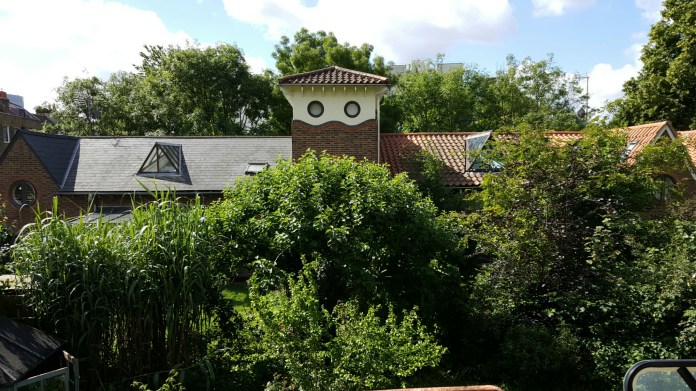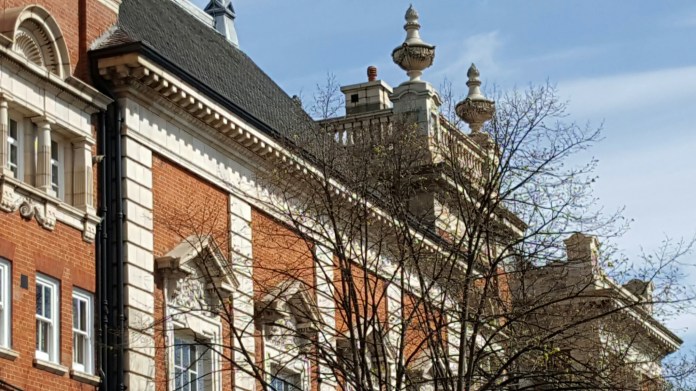In walking down Salmon Lane this morning, I was reminded of the Chinese restaurant Good Friends which was a great attraction of the street and brought people out from the west end, including, I’ve discovered, Fay Maschler’s parents in the 1960s (although it only opened in 1967). Even better, from our perspective, as well as cheaper, was a restaurant called The Peking, which disappeared once West India Dock Road was widened, had a large fish tank from which one could select one’s dinner, and was presided over by a magnificent woman who was half-Chinese, a representative of the local Chinese community which was still in evidence in the early 1980s, but now may have gone.
Tag Archives: East London
Limehouse (1)
Since it was such a spectacularly beautiful morning, I decided to potter round some of my old haunts in Limehouse where we used to live. I got a good view of 5, Newell Street which was, and remains, a monument to early post-modernism, designed by Tom Brent in 1977 when he bought the whole of Nelson’s Wharf as an experiment in semi-communal living:-
Green Truffle
As gentrification creeps up the Roman Road, we’ve got a brand new Italian delicatessen at no. 21, opened last Wednesday, which stocks the finest fresh pasta and olive oil straight from Italy. After years of having nothing but chicken shops locally, it’s a pleasure to be able to stock up on different varieties of spaghetti:-
Unilever House
We had an All Staff Meeting this afternoon on the eighth floor of Unilever House which is normally closed to all but Unilever staff. There was a small spiral staircase up onto the roof, which, like many London rooftop views, gives one a different view of the city. Even the Walkie Talkie looked faintly interesting extending out of the potted shrubs:-
And Herzog and de Meuron’s brick ziggurat made sense seen from a distance as if growing mesolithically out of Giles Gilbert Scott’s power station:-
Bethnal Green
I walked yesterday through unfamiliar bits of Bethnal Green in an attempt to take a half way decent photograph of the Brady Street Cemetery, which can only be done by poking a telephone through the gate and hoping that the lens is pointing on the right direction.
I started through the Collingwood Estate, which in most weathers would be a bit grim – big, standardised, neo-Georgian blocks laid out in the 1920s and 1930s by the LCC under G. Topham Forrest. But it looked pretty good in the sun:-
Then the cemetery itself:-
Cleeve Workshops
I’m not sure that I have ever done a post about Cleeve Workshops, a group of sixteen worker’s units in a yard at the back of Cleeve House on Calvert Avenue. They were built in 1895 as one of the first parts of what became the Boundary Estate, planned by the Housing of the Working Classes Branch of the LCC Architects’ Department and designed by Reginald Minton Taylor. They now house small cafés and fashion studios, including S.E.H. Kelly:-
The People’s Palace
I have been meaning to do a post about the original People’s Palace, now subsumed into being the Queen’s Building at Queen Mary. It has a long and interesting history. Barber Beaumont, an eighteenth-century miniaturist who was trained at the Royal Academy Schools, turned in later life into an entrepreneur, establishing the Provident Life Institute and Bank of Savings. As a philanthropist, he set up the Eastern Athenaeum, a museum, library and concert hall in Beaumont Square, which later became the New Philosophic Institute in Mile End. His legacy also made possible the construction of a so-called People’s Palace, a rival to the Alexandra Palace in combining the functions of swimming pool, winter garden and concert hall. It was described by The Times as ‘a happy experiment in practical socialism’ and, at least to begin with, was wildly popular. The original building was designed by E.R. Robson, the architect of the London Board Schools, but burned down in 1931. It was taken over by Queen Mary in 1934:-
Cassland Road Board School
In wandering round East London, I am increasingly admiring of the scale and ambition of the London Board Schools. They were designed to be ‘Lighthouses, my boy ! Beacons of the future ! Capsules with hundreds of bright little seeds in each, out of which will spring the wiser, better England of the future’. The one in Cassland Road was opened in 1902, the year after education was taken over from central government by the local authorities and was designed by T.J. Bailey in the grandest Wrenaissance style in the middle of an area of market gardens. It is now – surprise, surprise – being converted into luxury flats:-
The French Hospital
Another big immigrant community was the Huguenots. They established a hospital in Bath Street off City Road in November 1718. By the mid-nineteenth century, it was dilapidated, so was moved to the green fields of Hackney where it re-opened in June 1865 in a French gothic building modelled on the Château de Chambord and designed by R.L. Roumieu. It turned into a Convent School in 1949 and has recently been converted into a branch of Mossbourne Academy with a new building next door designed by Jestico + Whiles:-
Albert Stern House
I was walking past Albert Stern House on the Mike End Road yesterday and stopped to read the plaque on its façade, which encapsulates the long history of Jewish settlement in the area. Originally A HOSPITAL FOR SICK POOR AND LYING-IN WOMEN FORMED PART OF THE HEBRA GUEMILUT HASSADIM ESTABLISHED IN 1665. The Jewish Cemetery immediately to the north had been established in 1657 by Sephardic Jews. In 1665, they set up a hospital immediately to the south on the main road out to Essex (Gemilut Hasadim means ‘the giving of loving-kindness’). Later this must have been amalgamated with the Beth Holim Hospital, which, according to the inscription, was founded in 1747, but originally in Leman Street. Albert Stern House (Sir Albert Stern was one of the inventors of the tank) was opened in 1913 as a home for the elderly, but in 1977 moved out to Wembley:-
















You must be logged in to post a comment.